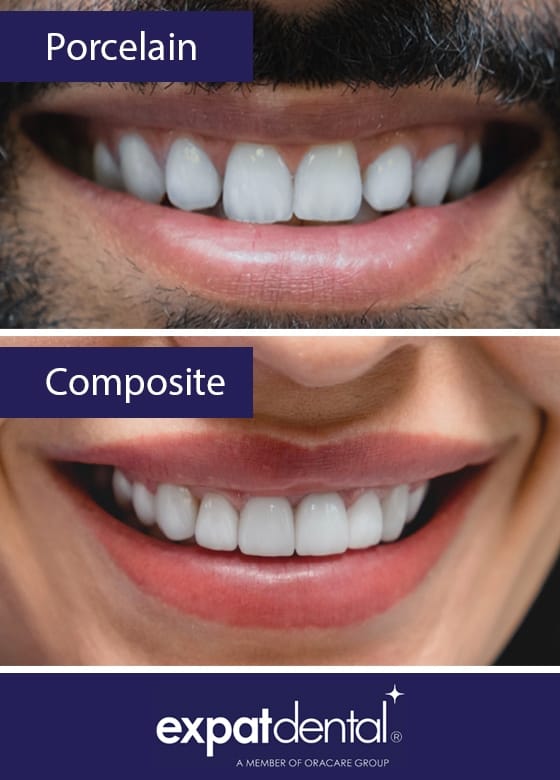Pros and Cons of Porcelain Vs. Composite Dental Veneers
Imagine you’re standing in front of a mirror, smiling brightly. Suddenly, you notice a tiny crack in one of your teeth, like a fault line in a porcelain vase.
You consider getting dental veneers to restore your smile, but you’re torn between porcelain and composite options. Both have their advantages and drawbacks.
Porcelain veneers are like sturdy porcelain figurines – they’re durable and can withstand the test of time. They also provide a natural, flawless appearance.
On the other hand, composite veneers are more affordable and reversible if you change your mind. However, they may not last as long and have a higher potential for staining.
In this article, we’ll explore the pros and cons of porcelain versus composite dental veneers, helping you make an informed decision for your pearly whites.
Key Takeaways
– Porcelain veneers offer exceptional durability and are resistant to staining and chipping.
– Porcelain veneers provide a natural appearance and can be custom-made to match existing teeth.
– Composite veneers are more affordable and eliminate the need for multiple dental visits.
– Porcelain veneers have greater stain resistance and are easier to clean and maintain compared to composite veneers.
Durability of Porcelain Veneers
Porcelain veneers offer exceptional durability, making them a reliable choice for enhancing your smile. These thin shells of porcelain are custom-made to fit over your natural teeth, providing a long-lasting solution for improving the appearance of your teeth. With proper care and maintenance, porcelain veneers can last for many years, giving you a beautiful and confident smile.
One of the reasons why porcelain veneers are so durable is because they’re made from high-quality materials that are resistant to staining and chipping. Unlike composite veneers, which are made from a mixture of resin and plastic, porcelain veneers are crafted from strong ceramic material. This makes them less prone to damage and discoloration, ensuring that your smile stays bright and beautiful.
Additionally, porcelain veneers are bonded to your teeth using a strong adhesive, providing a secure and long-lasting attachment. This means that you can continue to enjoy your favorite foods and drinks without worrying about your veneers coming loose or falling off.
Natural Appearance of Porcelain Veneers
When it comes to the natural appearance of dental veneers, porcelain offers a realistic and lifelike look that can seamlessly blend with your natural teeth. Porcelain veneers are designed to mimic the translucency and color variations of natural tooth enamel, resulting in a smile that looks both beautiful and authentic.
Here are four reasons why porcelain veneers provide a natural-looking solution for enhancing your smile:
– Customization: Porcelain veneers can be custom-made to match the shape, size, and color of your existing teeth, ensuring a seamless integration with your smile.
– Stain Resistance: Porcelain is highly resistant to staining, allowing your veneers to maintain their natural appearance for years to come, even when exposed to common staining agents like coffee or red wine.
– Light Reflection: Porcelain veneers reflect light in a similar way to natural teeth, creating a natural luster and shine that enhances the overall aesthetics of your smile.
– Smooth Texture: The smooth surface of porcelain veneers not only feels natural but also prevents bacteria from adhering to the surface, promoting better oral hygiene and overall dental health.
With porcelain veneers, you can achieve a smile that not only looks beautiful but also appears completely natural.
Affordability of Composite Veneers
If you’re looking for a more cost-effective option, composite veneers offer an affordable alternative for enhancing your smile. Unlike porcelain veneers, which can be quite expensive, composite veneers are a more budget-friendly option for those seeking to improve the appearance of their teeth.
Composite veneers are made from a tooth-colored resin material that’s directly applied to the surface of your teeth. This eliminates the need for multiple dental visits and allows for a quicker and more affordable treatment process. Additionally, composite veneers can be easily repaired if they become chipped or damaged, saving you money in the long run.
While composite veneers may not be as durable as porcelain veneers, they can still last for several years with proper care. Regular brushing, flossing, and dental check-ups can help maintain the longevity of your composite veneers and ensure that you get the most out of your investment.
It’s important to note that the cost of composite veneers can vary depending on factors such as the number of teeth being treated and the complexity of the case. However, in general, composite veneers are a more affordable option compared to porcelain veneers.
If you’re looking to enhance your smile without breaking the bank, composite veneers may be the right choice for you. Consult with your dentist to determine if composite veneers are a suitable option for your specific dental needs and budget.
Reversibility of Composite Veneers
Consider the reversibility of composite veneers before making your decision. While composite veneers offer a range of benefits, it’s important to understand that they aren’t as easily reversible as porcelain veneers. Here are some key points to consider:
– Composite veneers require the removal of a small amount of tooth enamel, which can’t be reversed. Once the enamel is removed, it can’t be replaced.
– Composite veneers are bonded to the teeth using a special resin. While they can be removed, the process may cause some damage to the underlying tooth structure.
– If you decide to remove composite veneers, it may be necessary to replace them with another form of restoration, such as porcelain veneers or dental crowns. This can add to the overall cost and time involved in the treatment.
– It’s important to carefully discuss the potential for reversibility with your dentist before proceeding with composite veneers. They can provide you with a clear understanding of the process and help you make an informed decision.
Understanding the reversibility of composite veneers is crucial in making the right choice for your dental needs. Consult with your dentist to explore all the options available and determine the best course of action for achieving your desired smile.
Maintenance and Longevity of Porcelain Veneers
To maintain and ensure the longevity of your porcelain veneers, it’s essential that you follow proper oral hygiene practices and regularly visit your dentist for check-ups. Taking care of your veneers is crucial to maximize their lifespan and keep them looking their best.
First and foremost, practicing good oral hygiene is key. Brush your teeth at least twice a day with a soft-bristled toothbrush and fluoride toothpaste. Floss daily to remove plaque and food particles from between your teeth and around the veneers. Avoid using toothpaste that’s too abrasive as it can scratch the surface of the veneers.
Additionally, be mindful of what you eat and drink. Limit your consumption of foods and beverages that can stain your teeth, such as coffee, tea, red wine, and berries. If you do indulge in these items, rinse your mouth with water afterward to minimize staining.
Regular dental check-ups are essential for the maintenance of your veneers. Your dentist will assess the condition of your veneers, clean them professionally, and address any concerns or issues that may arise. They can also provide guidance on proper oral care techniques specific to your veneers.
Potential for Staining With Composite Veneers
When it comes to potential staining, composite veneers carry a higher risk compared to porcelain.
While composite veneers can discolor over time due to exposure to coffee, tea, and other staining agents, porcelain veneers are more resistant to stains.
This makes porcelain veneers a better option for individuals who want to maintain a long-lasting and stain-free smile.
Staining Risks With Composites
Watch out for potential staining when you wear composite veneers. While composite veneers offer several advantages, they do come with the risk of staining.
Here are some reasons why staining can occur with composite veneers:
– Composite material is porous, making it more susceptible to staining compared to porcelain veneers.
– Drinking beverages like coffee, tea, and red wine can cause stains on composite veneers.
– Smoking or using tobacco products can also lead to discoloration of the veneers.
– Poor oral hygiene and neglecting regular dental cleanings can contribute to staining as well.
To maintain the appearance of your composite veneers, it’s important to minimize exposure to staining agents and maintain good oral hygiene habits. Regular brushing, flossing, and professional cleanings can help prevent or minimize staining.
Porcelain’s Stain Resistance
Porcelain veneers offer greater stain resistance compared to composite veneers due to their non-porous material composition. This means that they’re less likely to absorb substances that could cause staining, such as coffee, tea, or tobacco.
Porcelain veneers are made from a strong and durable ceramic material that’s resistant to discoloration. They’re also more resistant to surface stains, making them easier to clean and maintain their natural appearance.
On the other hand, composite veneers are made from a resin material that’s slightly porous, making them more prone to staining over time. While composite veneers can still be polished and cleaned, they may require more frequent maintenance to keep them looking their best.
Comparing Long-Term Durability
To compare the long-term durability and potential for staining with composite veneers, consider their susceptibility to discoloration and maintenance requirements.
Composite veneers have a few factors that can affect their durability and staining potential. Here are some important points to consider:
– Composite veneers are more prone to staining compared to porcelain veneers, especially if you consume foods and beverages that are known to cause stains, such as coffee, tea, and red wine.
– Proper maintenance and regular dental check-ups are essential to keep composite veneers looking their best. This includes regular cleaning with non-abrasive toothpaste and avoiding abrasive dental products.
– Composite veneers may require occasional repairs or replacements over time, as they’re more susceptible to chipping and wear compared to porcelain veneers.
– It’s important to follow your dentist’s instructions for maintenance and care to ensure the longevity of your composite veneers.
Frequently Asked Questions
Are Porcelain Veneers More Resistant to Chipping or Breaking Compared to Composite Veneers?
Porcelain veneers are generally more resistant to chipping or breaking compared to composite veneers. This is because porcelain is a strong and durable material that can withstand the pressures of daily use. However, it’s important to note that even porcelain veneers can chip or break if subjected to excessive force or trauma.
Composite veneers, on the other hand, may be more prone to chipping or staining over time.
Can Composite Veneers Achieve the Same Level of Natural Appearance as Porcelain Veneers?
Composite veneers can achieve a similar level of natural appearance as porcelain veneers. They’re made from a tooth-colored resin material that can be shaped and polished to match the color and texture of your natural teeth.
Although porcelain veneers may have a slightly more translucent and lifelike appearance, composite veneers can still provide a beautiful and natural-looking smile.
Additionally, composite veneers offer the advantage of being more affordable and easier to repair if they get damaged.
Is There a Significant Price Difference Between Porcelain and Composite Veneers?
Is there a significant price difference between porcelain and composite veneers?
The cost of porcelain and composite veneers can vary. Porcelain veneers tend to be more expensive than composite veneers due to their higher quality and durability. However, composite veneers are a more affordable option and can still provide satisfactory results.
It’s important to consider your budget and consult with your dentist to determine which option is best for you.
Can Composite Veneers Be Easily Removed or Replaced if Desired?
Yes, composite veneers can be easily removed or replaced if desired. Unlike porcelain veneers, which require more extensive preparation and may need to be completely replaced, composite veneers can be adjusted or removed without damaging the underlying tooth structure. This makes them a more flexible option if you want to make changes to your smile in the future.
However, it’s important to consult with your dentist to determine the best option for your specific needs and preferences.
How Long Can Porcelain Veneers Be Expected to Last With Proper Maintenance?
With proper maintenance, porcelain veneers can be expected to last for a long time. They’re known for their durability and resistance to stains. By following good oral hygiene practices, such as regular brushing and flossing, you can help extend the lifespan of your porcelain veneers.
It’s important to note that individual results may vary, and factors such as tooth grinding or biting on hard objects can affect the longevity of your veneers. Regular check-ups with your dentist will ensure that your veneers are in good condition.
Conclusion
In conclusion, when deciding between porcelain and composite dental veneers, it’s important to consider factors such as:
– Durability: Porcelain veneers offer a long-lasting solution.
– Natural appearance: Porcelain veneers provide a more natural-looking result.
– Affordability: Composite veneers are more affordable compared to porcelain.
– Reversibility: Composite veneers can be easily reversed if desired.
– Maintenance: Both types of veneers require regular maintenance and oral hygiene.
– P click site otential for staining: Composite veneers may be more prone to staining.
Ultimately, the choice depends on individual preferences and needs.

Welcome to my website! I’m Declan Gaffney, a dedicated and passionate Preventive Dentist with years of experience in promoting oral health and providing top-notch dental care. I am thrilled to share my knowledge and expertise with you through this platform.

